Publisher’s Note: I awoke Friday morning to the news that one of my boyhood hero’s had passed on to the great Field in the Heavens. I spent most of my youth during the summers where I had been born – lees than an hour from Milwaukee – sitting on the lawn in front of my Grandfather’s home – with Uncle Charlie, where we would listen to Hank, Lew, Eddie, Warren and the rest of my favorite team “play ball.” Save me a seat in the Heavenly Bleachers and I will be along soon enough Mr. Aaron. RIP ~ Jeffrey Bennett
He held the most celebrated record in sports for more than 30 years.
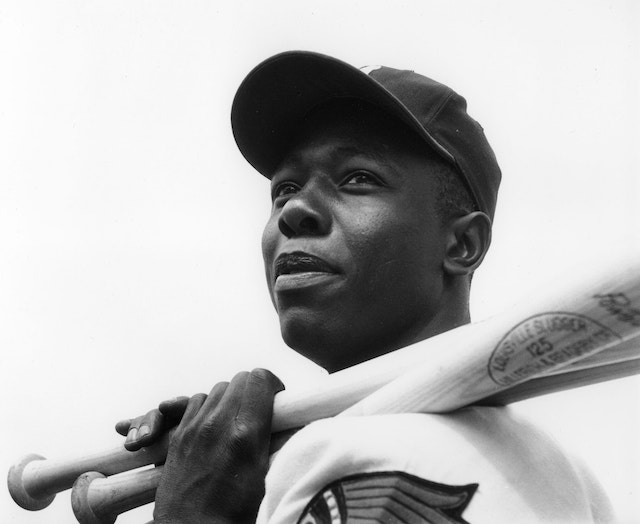
Hank Aaron was among the greatest all-around players in baseball history, earning his home run record in the face of hate mail and even death threats.Credit…Mark Rucker/Transcendental Graphics, via Getty Images
January 22, 2021 ~ Hank Aaron, who faced down racism as he eclipsed Babe Ruth as baseball’s home run king, hitting 755 homers and holding the most celebrated record in sports for more than 30 years, has died. He was 86.
Playing for 23 seasons, all but his final two years with the Braves in Milwaukee and then Atlanta, Aaron was among the greatest all-around players in baseball history and one of the last major league stars to have played in the Negro leagues.
But his pursuit of Ruth’s record of 714 home runs proved a deeply troubling affair beyond the pressures of the ball field. When he hit his 715th home run, on the evening of April 8, 1974, against the Los Angeles Dodgers at Atlanta-Fulton County Stadium, he prevailed in the face of hate mail and even death threats spewing outrage that a Black man could supplant a white baseball icon.
Aaron was routinely brilliant, performing with seemingly effortless grace, but he had little flash, notwithstanding his nickname in the sports pages, Hammerin’ Hank. He long felt that he had not been accorded the recognition he deserved.
He played for teams far beyond the news media centers of New York and the West Coast, and his Braves won only two pennants and a single World Series championship, those coming long before he approached Ruth’s record.
Aaron did not enjoy the idolatry accorded the Yankees’ Mickey Mantle or match the exuberance and electric presence of the Giants’ Willie Mays, his outfield contemporaries and rivals for acclamation as the greatest ballplayer in major league history.
But when he was elected to the Baseball Hall of Fame in 1982, his first year of eligibility, Aaron received 97.8 percent of the vote from baseball writers, second at the time only to Ty Cobb, who was inducted in 1936.
Aaron grew up in Alabama amid rigid segregation and its humiliations, and he faced abuse from the stands while playing in the South as a minor leaguer. Years later, he felt that Braves fans were largely indifferent or hostile to him as he chased Ruth’s record. And the baseball commissioner at the time, Bowie Kuhn, was not present when he hit his historic 715th home run.
All that, and especially the hate mail that besieged him, seared Aaron for years to come.
As the 20th anniversary of his home run feat approached in the early 1990s, he told the sports columnist William C. Rhoden of The New York Times, “April 8, 1974, really led up to turning me off on baseball.”
“It really made me see for the first time a clear picture of what this country is about,” he said. “My kids had to live like they were in prison because of kidnap threats, and I had to live like a pig in a slaughter camp. I had to duck. I had to go out the back door of the ball parks. I had to have a police escort with me all the time. I was getting threatening letters every single day. All of these things have put a bad taste in my mouth, and it won’t go away. They carved a piece of my heart away.”
 Aaron’s achievements went well beyond his home run prowess. In fact, he never hit as many as 50 homers in a single season.
Aaron’s achievements went well beyond his home run prowess. In fact, he never hit as many as 50 homers in a single season.
He was a two-time National League batting champion and had a career batting average of .305. He was the league’s most valuable player in 1957, when the Milwaukee Braves won their only World Series championship. He was voted an All-Star in all but his first and last seasons, and he won three Gold Glove awards for his play in right field.
Aaron combined with the Hall of Fame third baseman Eddie Mathews for 863 home runs during their 13 years together on the Braves, the most ever for two teammates.
Aaron remains No. 1 in the major leagues in total bases (6,856) and runs batted in (2,297); No. 2 in at-bats (12,364), behind Pete Rose; and No. 3 in hits (3,771), behind Rose and Cobb. He won the National League’s single-season home run title four times, though his highest total was only 47, in 1971. Matching his jersey number, he hit exactly 44 home runs in four different seasons.
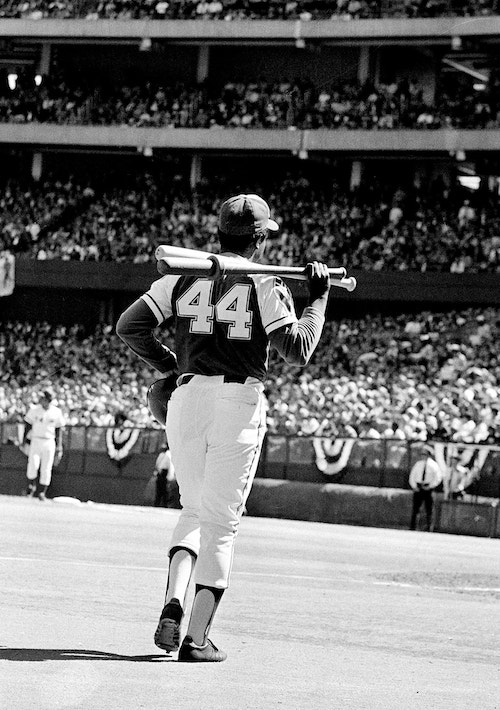
On April 4, 1974, Aaron hit his 714th home run, tying Ruth’s record, during a game against the Cincinnati Reds before a sellout crowd of 52,154 at Riverfront Stadium.Credit…Associated Press
At six feet tall and 180 pounds, Aaron was hardly the picture of a slugger, but he had thick, powerful wrists, enabling him to whip the bat out of his right-handed stance with uncommon speed.
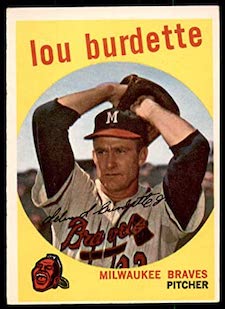 “He had great forearms and wrists,” Lew Burdette, the outstanding Braves pitcher, recalled in Danny Peary’s oral history “We Played the Game” (1994). “He could be fooled completely and be way out on his front foot, and the bat would still be back, and he’d just roll his wrists and hit the ball out of the ballpark.”
“He had great forearms and wrists,” Lew Burdette, the outstanding Braves pitcher, recalled in Danny Peary’s oral history “We Played the Game” (1994). “He could be fooled completely and be way out on his front foot, and the bat would still be back, and he’d just roll his wrists and hit the ball out of the ballpark.”
Aaron was quick on the bases and in the outfield.
“There aren’t five men faster in baseball, and no better base runner,” Bobby Bragan, Aaron’s manager in the mid-1960s, told Sports Illustrated. “If you need a base, he’ll steal it quietly. If you need a shoestring catch, he’ll make it, and his hat won’t fly off and he won’t fall on his butt. He does it like DiMaggio.”
Aaron was a keen student of pitching and kept himself in excellent shape.
“I concentrated on the pitchers,” he said in his memoir, “I Had a Hammer” (1991, with Lonnie Wheeler). “I didn’t stay up nights worrying about my weight distribution, or the location of my hands, or the turn of my hips: I stayed up thinking about the pitcher I was going to face the next day. I used to play every pitcher in my mind before I went to the ballpark.”
Dusty Baker, later a longtime manager, was mentored by Aaron when he was a young player with the Braves.
“Nobody had concentration like he did, sitting there in the dugout, looking at the pitcher through the little hole in his cap to focus on the release point,” Baker once said. “Never saw anyone do that before Hank.”
Baker said Aaron had been hampered by sciatic nerve problems but had the ability to “think away the pain and to condition himself like no other baseball player of his time.”
The San Francisco Giants’ Barry Bonds surpassed Aaron’s home run record in August 2007 and went on to hit 762 homers. But many inside baseball and out considered Bonds’s achievement to be tainted by suspicions that he had used performance-enhancing drugs in what came to be known as baseball’s steroid era, when bulked-up players achieved stunning feats of slugging.
Aaron did not speak out on steroid use, but he declined to follow Bonds around the league to witness his 756th home run. When it came in San Francisco against the Washington Nationals, Aaron limited himself to a message on the stadium’s video board: “My hope today, as it was on that April evening in 1974, is that the achievement of this record will inspire others to chase their own dreams.”
A Path Away From Poverty
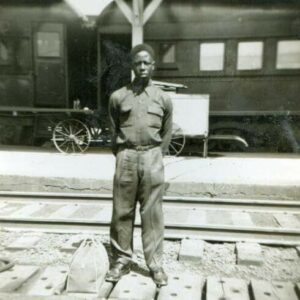 Henry Louis Aaron was born on Feb. 5, 1934, in Mobile, Ala., one of eight children of Herbert and Estella (Pritchett) Aaron. His father worked in shipyards. His mother joined with her husband in overseeing a close-knit family. She encouraged Henry (he never liked being called Hank, as he would customarily be known on the sports pages) to consider going to college.
Henry Louis Aaron was born on Feb. 5, 1934, in Mobile, Ala., one of eight children of Herbert and Estella (Pritchett) Aaron. His father worked in shipyards. His mother joined with her husband in overseeing a close-knit family. She encouraged Henry (he never liked being called Hank, as he would customarily be known on the sports pages) to consider going to college.
In March 1948, a year after Jackie Robinson broke the modern major league color barrier with the Brooklyn Dodgers, Robinson was in Mobile for a spring training game. Henry Aaron was in the crowd of Black youngsters who had gathered in town to hear Robinson tell them of the possibilities that would be opening to Black people.
Robinson spoke of the need to strive for a good education. But Henry, only 14 but already a talented sandlot ballplayer, cared little for his high school studies. He idolized Robinson and envisioned professional baseball as the road to escaping poverty and segregation.
While a teenager, he played alongside men many years his senior as a shortstop for the semipro Mobile Black Bears. (Mobile over the years was a breeding ground for top baseball talent, producing Satchel Paige and later the Hall of Famers Billy Williams and Willie McCovey.) He was then signed by the Negro leagues’ Indianapolis Clowns, a barnstorming team that combined entertainment with baseball, much like basketball’s Harlem Globetrotters.
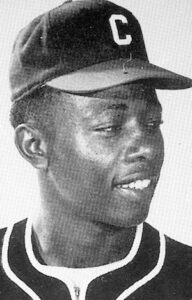
Aaron began the 1952 season with the Negro leagues’ Indianapolis Clowns, but he was signed in June by the Braves, who were in their last season in Boston.Credit…Negro Leagues Baseball Museum, Inc.
After beginning the 1952 season with the Clowns, Aaron was signed in June by the Braves, who were in their last season in Boston. They assigned him to play for their farm team in Eau Claire, Wis., and he was named the Northern League’s rookie of the year that season.
He was promoted in 1953 to play second base for the Jacksonville, Fla., team of the South Atlantic League, or the Sally League, becoming one of the circuit’s first five Black players.
Now he was back in the Old South.
“The whites used to yell from the stands and call us alligator bait,” Felix Mantilla, an infielder from Puerto Rico who roomed with Aaron at Jacksonville and later joined him in Milwaukee, told Howard Bryant in “The Last Hero: A Life of Henry Aaron” (2010).
“Jacksonville wasn’t so bad. But places like Columbus and Macon, those places were wicked.”
Aaron led the Sally League in hitting and was voted its most valuable player. But he was a poor infielder, so he learned to play the outfield in Puerto Rican winter ball and in 1954 earned a trip to spring training with the Braves, who were in their second season in Milwaukee.
Historic Career Begins
When outfielder Bobby Thomson, newly acquired from the New York Giants (less than three years after his celebrated pennant-winning homer at the Polo Grounds), broke an ankle during the exhibition season, Aaron took his place.
He hit his first major league home run on April 23, at Sportsman’s Park in St. Louis, off the Cardinals’ Vic Raschi, the former Yankee standout. Thomson returned in July, but Aaron remained a regular until he, too, broke an ankle early in September. He finished with 13 home runs and a .280 batting average.
Aaron emerged as a star in 1955, hitting .314, and he won his first batting title the following season, batting .328. When he was voted the National League’s Most Valuable Player in 1957, he came close to capturing the batting triple crown, leading the league in home runs (44) and runs batted in (132) and finishing in a tie for third place in hitting with a .322 average.
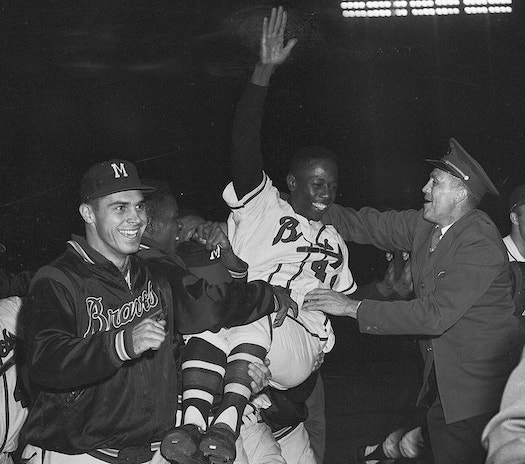
Aaron’s Braves teammates carried him off the field after his 11th-inning home run against the Cardinals lifted Milwaukee to the 1957 National League pennant on Sept. 23.Credit…Associated Press
The Braves won their first pennant in Milwaukee in 1957, clinching it with Aaron’s 11th-inning home run against the Cardinals on Sept. 23.
In the World Series, Aaron hit .393 with three home runs as the Braves defeated the Yankees in seven games. Milwaukee won the pennant again in 1958, this time losing to the Yankees in a seven-game World Series.
Aaron had his only three-homer game on June 21, 1959, at the San Francisco Giants’ Seals Stadium, their home before moving to Candlestick Park. He won his second batting title that season, hitting .355, but the Braves lost a pennant playoff to the Dodgers.
Aaron’s younger brother Tommie joined the Braves in 1962, playing regularly as a first baseman and outfielder, and on June 12, the brothers hit home runs in the same game, against the Dodgers. On Aug. 20, 1965, Aaron and Mathews became the No. 1 home run tandem in major league history, surpassing the mark of 722 homers hit by Ruth and Lou Gehrig with the Yankees.
With the Braves no longer pennant contenders and attendance declining, they moved to Atlanta in 1966. But they returned to the top of the standings in 1969, capturing the National League West after a divisional alignment and the playoff system had been put into place.
In the first National League Championship Series, Aaron hit three home runs, but the Braves were swept in three games in the year of the Miracle Mets.
Aaron became the ninth player to achieve the 3,000-hit milestone when he singled against the Reds at Crosley Field in Cincinnati on May 17, 1970. In February 1972, he became the highest-paid player in baseball history, signing a three-year, $600,000 deal (about $3.7 million in today’s money).
When he won the home run title in 1957 with 44, Aaron was slashing line drives all over the park, almost half of them having been opposite-field homers, to right field. But by the early 1970s he was pulling the ball more. He hit 34 home runs in the strike-shortened 1972 season.
A Record Nears
As Aaron chased Ruth’s record in 1973, he finally emerged as a national figure. He appeared on the covers of Time and Newsweek and was sought out for television and newspaper interviews.
Charles Schulz, whose “Peanuts” comic strip had become a staple of national popular culture, turned his attention to Aaron in August 1973 with drawings that ridiculed the bigots besieging him.
Aaron received some 930,000 pieces of fan mail, but among the good wishes were numerous racist letters. Some contained threats, and those were turned over to the F.B.I. The Braves hired two Atlanta police officers to sit in the stands while off duty, overlooking Aaron in the outfield, in the event of trouble.
Aaron was 39 years old that season and appeared in only 120 games. After he hit his 700th home run on July 21 off the Philadelphia Phillies’ Ken Brett in Atlanta, he said he was “kind of disappointed” over the failure of Commissioner Kuhn to convey congratulations. Kuhn responded by saying he was one of Aaron’s biggest rooters, and he promised to lead the celebration when he hit Nos. 714 and 715.
Aaron hit 40 home runs in the 1973 season, leaving him one shy of Ruth’s record, with 713.
As Aaron chased Ruth’s record in 1973, he finally emerged as a national figure. He appeared on “The Flip Wilson Show” in October of that year.Credit…United Press International
The off-season was filled with anticipation, and it also held commercial opportunities. Though Aaron had received few promotional offers in his career, the television manufacturer Magnavox signed him in January 1974 to a five-year, $1 million contract in anticipation of his breaking Ruth’s record.
But there were troubles anew as spring training loomed. The Braves’ ownership said it intended to keep Aaron out of the team’s three-game season-opening series in Cincinnati so that he would have a chance to tie and break Ruth’s record when the team returned for its opening homestand, a presumed box-office bonanza.
Aaron seemed amenable enough. “The people of Atlanta are the people I have to please,” he said at a sports dinner. “I believe I owe it to them.”
But Kuhn told the Braves that he expected them to play Aaron in at least two of the three games in Cincinnati, citing the integrity of the game.
Aaron was in the lineup when the Braves opened against the Reds on Thursday afternoon, April 4, before a sellout crowd of 52,154 at Riverfront Stadium. He came to the plate in the first inning with two men on base and one out, facing Jack Billingham, a 19-game winner the previous season. Aaron let the first four pitches go by, the count reaching 3 and 1, and then Billingham delivered a sinker that headed toward the outside part of the plate but tailed in. Aaron lashed a rising liner that cleared the 12-foot-high wall slightly to the left of the 375-foot sign in left-center field.
No. 714 flashed on the scoreboard above the upper deck in center field as a Cincinnati police officer caught the baseball on the first bounce after it had fallen into the gap between the outfield fence and a high wall fronting the stands. Aaron trotted around the bases, his head held high, his elbows back.
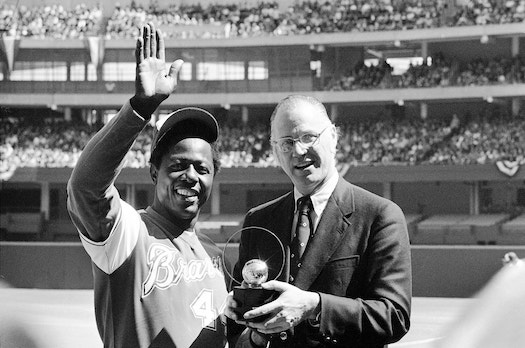
Bowie Kuhn, the baseball commissioner, presented Aaron with a trophy on the field in Cincinnati after his 714th home run. Credit…Bob Johnson/Associated Press
He received a standing ovation as his teammates swarmed out of their dugout to greet him. Moments later, Kuhn and Vice President Gerald R. Ford, who had thrown out the first ball, went onto the field to congratulate him. A member of the Reds’ grounds crew retrieved the baseball from the police officer, and it was presented to Aaron.
Later in the game, Aaron was retired twice and walked. He was not in the starting lineup for the second game in Cincinnati but played in the third game after Kuhn threatened penalties against the Braves if he were held out again. Aaron went homerless in that game in any case, remaining tied with Ruth.
The Braves opened their home schedule the following Monday night against the Los Angeles Dodgers, before a record home crowd of 53,775. In the fourth inning, with a misty rain falling and nobody on base, Aaron strode to the plate, facing the left-hander Al Downing. Ball one.
Next came a fastball down the middle, and Aaron connected. He drove the ball 400 feet over the left-center field fence for home run No. 715.
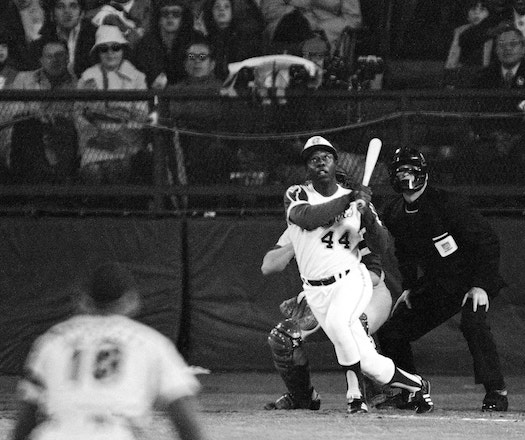
Aaron watched the flight of the ball on his 715th home run. He broke a record that had stood since Ruth hit his last major league home run in 1935. Credit…Harry Harris/Associated Press
The fans erupted with an 11-minute ovation, and Tom House, a reliever for the Braves, returned the ball from the Atlanta bullpen.
The veteran Dodgers broadcaster Vin Scully waited while the roars resounded, and then he spoke to the history of the moment, on the diamond and beyond it.
“What a marvelous moment for baseball,” he said. “What a marvelous moment for Atlanta and the state of Georgia. What a marvelous moment for the country and the world. A Black man is getting a standing ovation in the Deep South for breaking a record of an all-time baseball idol.”
Aaron’s parents came onto the field, and there were hugs all around. Aaron was finally receiving the adulation that he had long felt his due. In addition to the Magnavox deal, there were some 230 “Atlanta Salutes Hank Aaron” billboards posted around the city, with corporate sponsorship.
Aaron was mobbed by his teammates following his 715th home run. Despite the death threats that Aaron received before breaking the record, security at Atlanta’s stadium failed to prevent a few fans from getting onto the field and circling the bases with Aaron.Credit…Associated Press
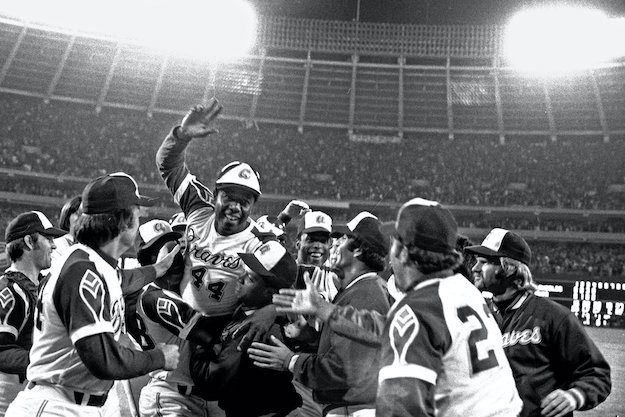
Aaron was mobbed by his teammates following his 715th home run. Despite the death threats that Aaron received before breaking the record, security at Atlanta’s stadium failed to prevent a few fans from getting onto the field and circling the bases with Aaron. Credit…Associated Press
But when Aaron hit homer No. 715, Kuhn was not present. The commissioner was in Cleveland, speaking to an Indians booster organization. He sent Monte Irvin, an official in his office and one of baseball’s first outstanding African-American players, with the New York Giants, to represent him. Aaron viewed it as a snub, and he did not forget it.
In mid-June, when the Braves played the Mets in their first series of the season at Shea Stadium, Aaron was presented with New York City’s Gold Medal, its highest award, by Mayor Abraham D. Beame in a ceremony outside City Hall. He toured Harlem in a motorcade and spoke to 5,000 young people at Marcus Garvey Park.
But there were discordant notes as well. When Mathews, his slugging teammate, was fired as manager just before the 1974 All-Star Game, Aaron said he felt “a little bit insulted” at not being offered the opportunity to become major league baseball’s first Black manager.
The post went instead to Clyde King, a veteran baseball man. The following season, Frank Robinson, who died in 2019, became the first Black manager, with the Indians.
Back to Milwaukee
Aaron had little interest in continuing to play for the Braves after the 1974 season. He felt that notwithstanding Atlanta’s reputation as a progressive representative of the New South, he had received only tepid backing from the fans as he neared Ruth’s record. And he heard racial abuse from some fans that reminded him of his minor league days in the Sally League.
“I didn’t expect the fans to give me a standing ovation every time I stepped on the field, but I thought a few of them might come over to my side as I approached Ruth,” Aaron said in his memoir. “At the very least, I felt I had earned the right not be verbally abused and racially ravaged in my home ballpark.”
The modern civil rights movement made historic gains during Aaron’s career, but he knew that the road to equal treatment remained long.
“Any Black who thinks the same thing can’t happen today is sadly mistaken,” he told The Times in 1994. “It happens now with people in three-piece suits instead of with hoods on.”
Early on in his career, Black players were barred from hotels where white teammates stayed during spring training in Florida. Aaron joined with Bill Bruton, the Braves’ African-American center fielder, in pressing management for change, with no immediate success. Although Aaron wasn’t vocal on the larger civil rights scene, he became interested in the writings of James Baldwin, decrying patience in the face of racism.
Aaron contributed a chapter to “Baseball Has Done It,” Jackie Robinson’s 1964 collection of first-person accounts from baseball figures telling of their battles against racism.
“I’ve read some newspapermen saying I was just a dumb kid from the South with no education and all I knew was to go out there and hit,” Aaron wrote. “Baseball has done a lot for me, given me an education in meeting other kinds of people,” he continued. But he added pointedly, “It has taught me that regardless of who you are and how much money you make, you are still a Negro.”
Following his record-breaking 1974 season, Aaron was traded to the Milwaukee Brewers of the American League. He signed a two-year contract at $240,000 a season that enabled him to close out his major league career in the city where it began. In those two years, he hit 22 home runs, his 755th and final one coming on July 20, 1976, against Dick Drago of the California Angels.
That same year, Aaron was named the Braves’ vice president in charge of player development, overseeing their farm system. He held that post until 1989. He was later a senior vice president of the Braves and worked on behalf of the Hank Aaron Chasing the Dream Foundation, which helped gifted children develop their talent. His business interests included auto dealerships and fast-food restaurants.
The Atlanta Braves retired Aaron’s No. 44 in April 1977 and unveiled a statue, depicting him swinging, at Atlanta-Fulton County Stadium in 1982. They moved it to their second home, Turner Field, in 1997. The address of that facility, now known as Georgia State Stadium, is 755 Hank Aaron Drive.
A new statue that captures the moment of impact between bat and ball on Aaron’s 715th home run was created by the Atlanta-based artist Ross Rossin for SunTrust Park (now Truist Park), to which the Braves moved for the 2017 season.
Accolades in Later Years
On the 25th anniversary of Aaron’s 715th home run, Major League Baseball created the Hank Aaron Award, given annually to the players with the best overall offensive performances in each league.
Aaron received the Presidential Medal of Freedom, the nation’s highest civilian award, from President George W. Bush in 2002. The citation said he “embodies the true spirit of our nation.” The Baseball Hall of Fame opened a permanent exhibit in 2009 chronicling Aaron’s life. His childhood home was moved on a flatbed truck to the grounds of Hank Aaron Stadium, which was the home of the Mobile BayBears, a former minor league team, and opened as a museum in 2010.
Aaron is the 10th Baseball Hall of Famer to die since last April, and the third this year alone. The longtime Dodger manager Tommy Lasorda and the pitcher Don Sutton both died this month.

Aaron and his wife, Billye, at a ceremony celebrating the 40th anniversary of his 715th home run before the start of a game between the Braves and the Mets in Atlanta on April 8, 2014. Credit…David Goldman/Associated Press
Aaron’s survivors include his wife, Billye; two sons, Lary and Henry Jr., and two daughters, Dorinda and Gaile, all of whom he had with his first wife, Barbara (the marriage ended in divorce); and his daughter Ceci, from Billye Aaron’s first marriage. His brother Tommie, who played intermittently for the Braves for six seasons after his rookie year as a regular, died of leukemia in 1984 at age 45.
When Aaron celebrated his 80th birthday in February 2014, Billye Aaron and the baseball commissioner at the time, Bud Selig, hosted a party at the Hay-Adams hotel in Washington, where President Barack Obama and his family lived for two weeks before his first inauguration.
“There’s a young man who lives right over there whose life’s path was made easier by Henry Aaron,” Attorney General Eric H. Holder Jr. said as he glanced at the White House across the street, Sports Illustrated reported.
The Smithsonian Institution’s National Portrait Gallery unveiled an oil painting of Aaron by Mr. Rossin to mark the occasion.
The Braves honored Aaron at their home opener on April 8, 2014, the 40th anniversary of his breaking Ruth’s record. Though weak from a partial hip replacement after a fall, he spoke briefly. The number 715 had been mowed into the outfield grass, where 715 fans held baseball-shaped signs, each with a number and a date signifying every one of those home runs.
Aaron, Mays, Sandy Koufax and Johnny Bench were selected by fan balloting as the four greatest living players in a promotion leading up to the 2015 All-Star Game at Great American Ball Park in Cincinnati. They were introduced on the field before the first pitch.
Unique Among His Peers
For virtually all his major league career, Aaron competed against Willie Mays.
“It’s just not my way to be flashy or flamboyant the way, say, Willie is,” Aaron said in a 1970 interview with Sport magazine. “I have my own even rhythm, and I guess it just doesn’t attract the kind of attention that a more colorful style does.”
Both were raised in Alabama (Mays in Westfield and then Fairfield, about 225 miles north of Mobile), and they both played in the Negro leagues. But there was a perception of frostiness between them. When they were interviewed together by Bob Costas in 2008 for his HBO program “Costas Now,” they played down any antagonism. Aaron said there had been “competition” but “no resentment, no animosity.”
Aaron crossed baseball paths with Mickey Mantle in two World Series and in All-Star Games.
“If they had a choice of who they wanted to break Babe Ruth’s record, it would have been Mickey Mantle first,” he once said. “Mickey was like Marilyn Monroe. He didn’t have to be the greatest ballplayer. He had that charisma. The Yankees had won all those pennants.”
When he was inducted into the Hall of Fame, Aaron felt he had finally been accorded the respect he deserved. But he did not slight the Babe.
“It was always this player and that player and then Henry Aaron, but now I think I’m appreciated,” Aaron said. As for Ruth’s devotees: “I never wanted them to forget Babe Ruth. I just wanted them to remember Henry Aaron.”

Batting it to Heaven! RIP
Written by Richard Goldstein for The New York Times ~ January 22, 2021
FAIR USE NOTICE: This site contains copyrighted material the use of which has not always been specifically authorized by the copyright owner. We are making such material available in our efforts to advance understanding of environmental, political, human rights, economic, democracy, scientific, and social justice issues, etc. We believe this constitutes a ‘fair use’ of any such copyrighted material as provided for in section 107 of the US Copyright Law. In accordance with Title 17 U. S. C. Section 107, the material on this site is distributed without profit to those who have expressed a prior interest in receiving the included information for research and educational purposes. For more information go to: http://www.law.cornell.edu/uscode/17/107.shtml
